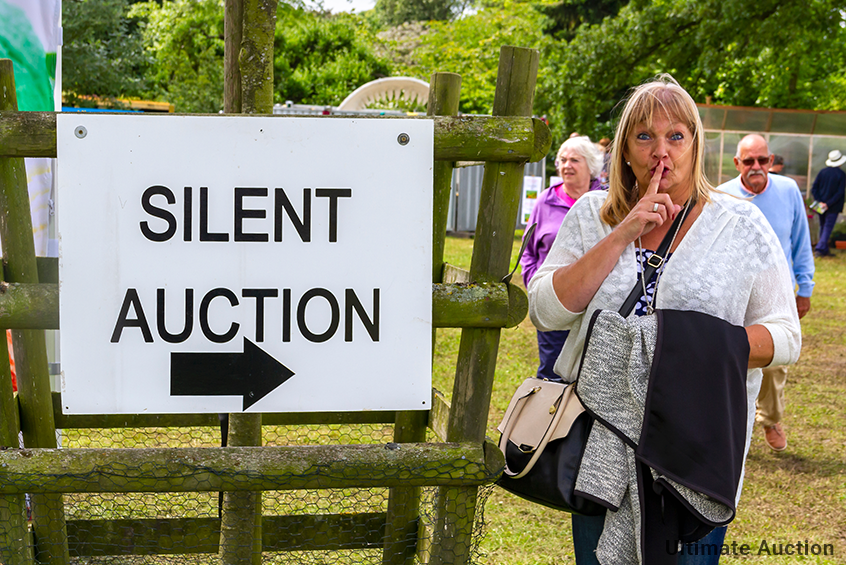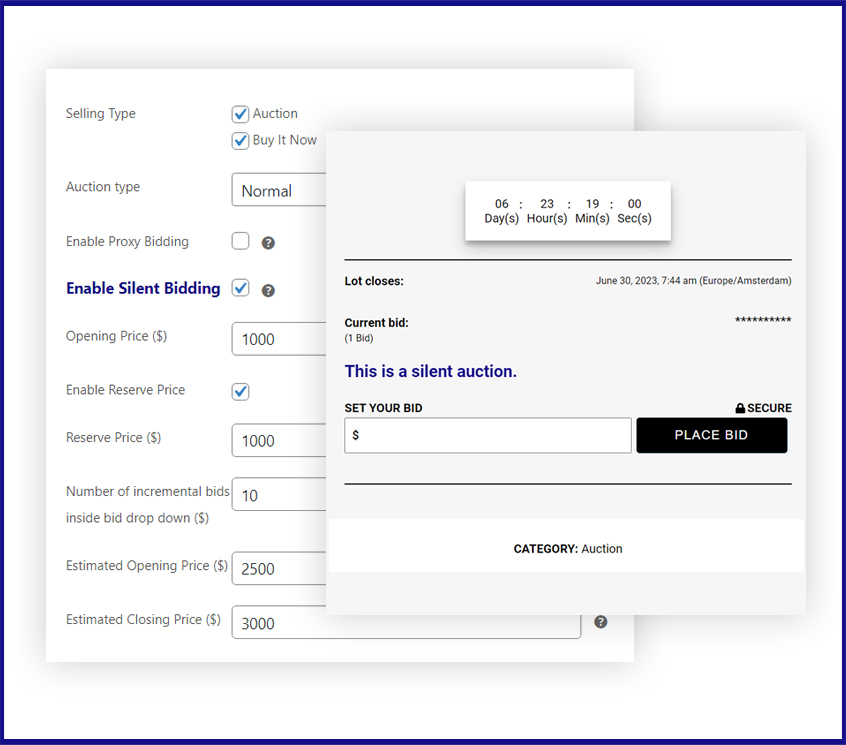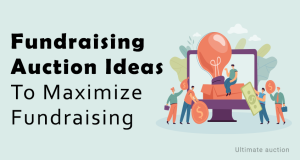How Does a Silent Auction Work? The Ultimate Fundraising Guide

The silent auction is one of the most inventive fundraising ideas that has stood the test of time. If you’re wondering how does a silent auction work online,don’t be misled by the word ‘silent’—it’s a lively and exciting way to raise funds for charitable causes.
This article will cover how a silent auction works, their best practices for success, the function of the auctioneer, and silent auction software.
How Does a Silent Auction Work? Understanding the Process
A silent auction is a fundraising event where guests can peruse and place bids on various featured items in private throughout the event. There is no need for an auctioneer because guests can bid anonymously on bid sheets or with mobile bidding apps. Until the auction concludes, attendees can place and raise bids; the winner is the highest bidder.
Get your Car Auction Website Instantly
Sell your car from your own website and earn Buyer’s Premium on it

How Does a Silent Auction Work? Best Practices for Success
Although each silent auction is unique, most of them adhere to a few essential best practices to make the event a success:
1. Promote Auction Items in Advance
Showcase a few auction items before the event to create anticipation and excitement. Provide a preview of the products through email newsletters, social media posts, and other marketing materials. In addition to generating interest, this pre-event marketing tactic motivates participants to schedule their bids ahead of time.
2. Decide on a Finish Time
Give the auction a precise closing time to instil a sense of urgency. This guarantees visitors submit bids on time and don’t lose out on things they want. Take into account your event’s schedule to prevent interruptions or competing events.
3. The Right Amount of Items
Make sure you have the appropriate amount of each item on hand. Experts advise against bringing more than one item per two guests as a general rule. An excessive number of items may overwhelm visitors and reduce the likelihood that anything will be bought.
4. Control Traffic Flow
Arrange the design to facilitate simple movement and visibility. The placement of the tables and other objects should promote adequate traffic flow. When an event goes well, participants can concentrate on bidding rather than getting trapped in crowded spots.
5. Organize Items Strategically
Sort the items by price, starting with the least expensive. This encourages participants to bid on various items rather than just the expensive ones. Better planning increases the diversity of bids.
Special Offer – Limited Time Only!
Rev Up Your Savings: Get 10% off Essential Ultimate Auction Software!
Fill the form and receive directly to your mailbox a discount code.
"*" indicates required fields
How Does a Silent Auction Work? A Guide to Running One
Now that we’ve laid the foundation, let’s dive into how to run a silent auction successfully. It’s more complex than placing items on tables and waiting for the bids to roll in. Here are the key steps to consider:
1. Promotion
The secret to a successful silent auction is effective promotion. Commence your marketing activities well in advance of the scheduled event. Use various marketing channels, including email marketing, social media, and, if necessary, traditional advertising. Here’s how to take full advantage of this critical step:
Social Media:
Post interesting updates and content on social media sites like Facebook, Twitter, and Instagram. Post eye-catching images of the things up for bid and generate excitement by scheduling countdown posts in the lead-up to the event.
Email Marketing:
Distribute email invitations and newsletters to the mailing list of your company. Highlight the essential items that will be up for bid and give a sneak peek at the event. Consider segmenting your emails according to your recipients’ interests to deliver more individualised content.
Sneak Peeks:
Give early access to some auction items as sneak peeks to spark interest. Potential bidders can get a preview of what’s to come with these teasers, which can be pictures, descriptions, or brief videos. This increases excitement and motivates participants to organise their bids.
2. Venue Selection
Your chosen location dramatically influences the entire experience of your silent auction. A well-chosen venue can guarantee a smooth operation of events and optimise participation from attendees. When selecting a location, keep the following in mind:
Space:
Give priority to a layout that permits guests to move freely and easily. It should be easy for visitors to move around the room without feeling congested or confined.
Display Area:
Make sure there is enough room for display tables to present auction items efficiently. These tables should be arranged so guests can easily view and interact with the items.
Accessibility:
Verify whether everyone attending, including those with mobility issues, can easily reach the location. Having enough parking and being close to public transportation are important factors.
Extra Facilities:
Ensure the venue has the space or amenities needed for food stations, bars, or catering services if you intend to serve food or refreshments.
3. Item Selection
When choosing auction items, it is crucial to understand your target audience. Selecting auction items that are most likely to draw bids will be easier if you are aware of the tastes and demographics of your guests. Here are some suggestions for choosing an item:
Audience Profiling:
Examine and evaluate your target audience’s interests and demographics. Are most people attending your events academics, young singles, seniors, or thrill seekers? Make sure the items you choose suit their tastes.
Diverse Items:
Provide a range of products to suit a range of palates. This could include collectables, art, technology devices, getaways, spa days, and more. A wider audience may be encouraged to participate in a variety of items.
Unique and Desirable:
Select things that are desirable, distinctive, and pertinent. Highlight the unique qualities of each item. This might be due to its value, rarity, or a personal connection to the cause.
4. Item Display
Attendees’ decisions to bid can be influenced by item descriptions, which give them important information about the items. The following should be mentioned in these descriptions:
Use of Platforms:
Raising objects to various levels or surfaces will result in an eye-catching display. This kind of item spacing guarantees that each piece is observable and gives the arrangement depth.
Proper Lighting:
To improve an item’s visibility, make sure it is well-lit. An item’s appearance can be enhanced by good lighting.
Staging:
Make visually appealing arrangements. Sort items into value- or theme-based groups, and use décor or props to improve the display’s overall appearance.
Easels and Signage:
Display item descriptions and extra information with easels and signage. This eliminates the need for attendees to continuously ask volunteers for information to learn more about the items.
5. Item Descriptions
Attendees’ decisions to bid can be influenced by item descriptions, which give them important information about the items. The following should be mentioned in these descriptions:
Item Details:
Give a thorough description of the item, covering all its attributes, features, and technical details pertinent to its worth or intended use.
Donor Information:
Emphasise the donor of the item. This strengthens credibility and may inspire gratitude for the donor.
Value:
Give the item’s estimated retail value or price. This aids participants in appreciating the value of the item they are bidding on.
Uniqueness:
Highlight any distinctive or noteworthy features of the product. This could be because of its historical significance, scarcity, or a personal anecdote.
Beneficiary:
Describe how the money generated by the item will help your cause. This gives bidders a stronger bond with the cause they are funding.
Get your Car Auction Website Instantly
Sell your car from your own website and earn Buyer’s Premium on it

6. Registration
Although registration is not always required for silent auctions, there are several benefits for both participants and organisers:
Anonymity:
Participants can maintain their anonymity throughout the bidding process by registering. A bidder number is given to each registered participant; they can use this number instead of their names.
Contact Information:
Registration gives organisers access to vital contact details. This can be helpful for post-event communications, such as providing details on successful bids and upcoming events.
Orderly Process:
The bidding process is streamlined and kept organised using bidder numbers. It also lessens the likelihood of misunderstandings or conflicts.
7. Bid Sheets
In a silent auction, the bidding sheets are the hub of activity. They are the primary means by which participants can bid on goods they want. When creating and utilizing bid sheets, keep the following in mind:
Clear Instructions:
Give precise directions on how to fill out the bidding form. Specify the location for writing the bid amount and bidder number. If your product has a “Buy Now” option, explain how to use it.
Buy Now Price:
If there is a “Buy Now” price for an item in your auction, ensure the bidding sheets make it obvious. This eliminates the need for attendees to wait to place a bid and enables them to make an instant purchase.
Volunteer Assistance:
Ensure volunteers are on hand to aid attendees with the bidding sheets or any questions. They can offer advice to participants on proper bid placement.
Organised Placement:
Ensure the bid sheets are arranged so guests can easily find and access them. Group them by item or category for a more organised display.
The Power of Silent Auction Software
Using technology to its full potential can elevate your silent auction event above its basic requirements for success. Auctioneer software has become a vital resource for businesses improving attendance and optimizing fundraising operations.

What is Silent Auction Software?
Software for silent auctions is a digital solution that makes managing and conducting silent auctions easier. It offers several advantages that can significantly improve your event, including donor engagement, money processing, bidding, and tracking.
In Conclusion:
Silent auctions are a great approach to generate money for a deserving organisation and give guests a pleasant and exciting experience. Your silent auction will go off without a hitch, and your guests will feel proud of themselves for helping your cause if you adhere to these best practices and put in place quick checkout and item collection processes.
And think about investigating the Ultimate Auction Pro Theme if you want to elevate your silent auctions to a new level. Whether you’re selling or bidding on things, this new auction theme, with its feature-rich and polished style, offers a distinctive architecture that boosts the effectiveness and success of your auctions.
Get your Car Auction Website Instantly
Sell your car from your own website and earn Buyer’s Premium on it

Get your own Auction Today!
Choose Your Plan
Easy Setup
5 Star Support



